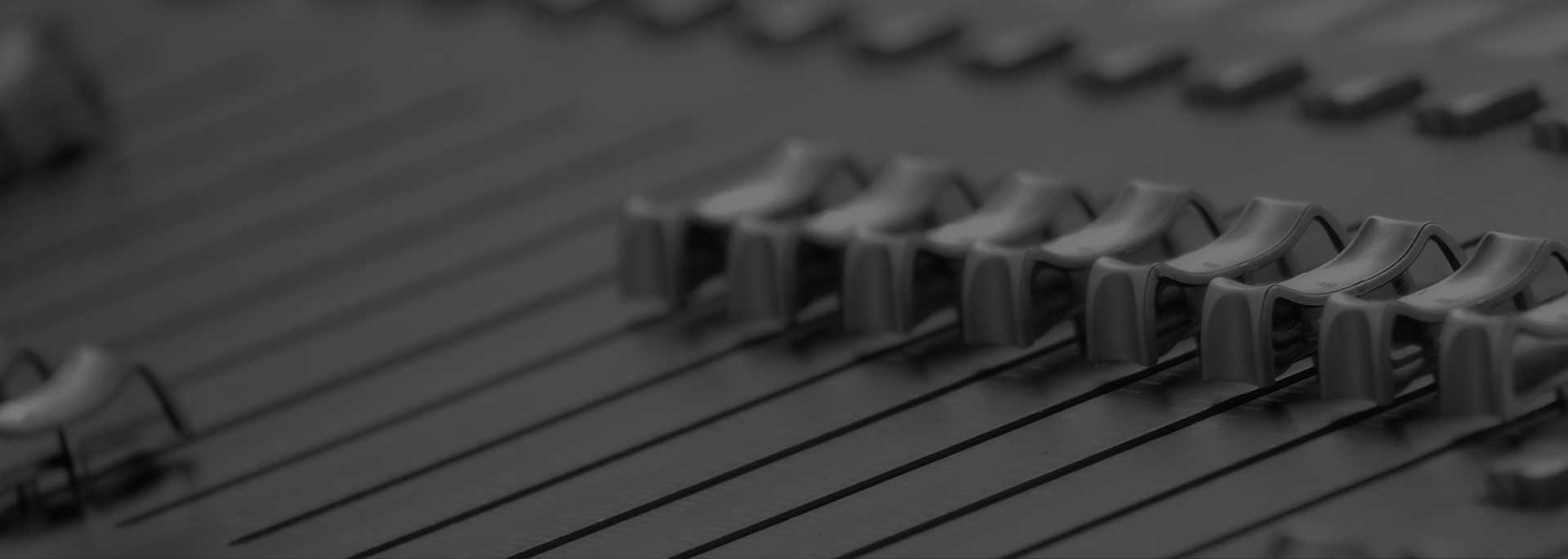You’re either a musician, podcaster, independent filmmaker, or other creative talent who wants to learn how a recording studio goes about creating amazing sound and music production. Or perhaps you’re just curious to learn more about audio production in general, and how it can add a shiny polish to any media project, vastly increasing its chances of success.
That’s great, because the producers, technicians, and audio engineers here at BKP Group and the necessary production skills, and live, breathe, and sleep audio production.
Our job is to produce music and give every project’s ‘sound’ an unmistakeable WOW factor that delights the ears of the intended audience, and stimulates their mind.
This article will cover the different stages of audio production and music production, the importance of high-quality sound, and the tools used in the audio production process.
What is Audio Production?
To start, audio production refers to the process of recording, editing, mixing, and mastering sound. The term isn’t exclusive to the music industry; it covers film production, television, radio, audio books, podcasts… plus, many more. Essentially, any commercial or creative endeavour that requires professional audio.
It’s about recording sound and making improvements, enhancements, or necessary creative changes in order to produce a releasable track. Only a qualified ‘ear’ can do this. Though, unfortunately, it’s not uncommon to see productions that have skipped this vital piece of the media production jigsaw, and made an otherwise great piece of work, completely unusable in a commercial setting. This is often the case in low-budget, independent film-making.
BKP music production engineers are hard-wired with these finely-tuned ears, and understand what’s needed to hit the music sweet spot and master the art of sound production.
What are the 5 Key Stages of Audio Production?

1. Pre-Production
The pre-production stage is the planning element of the entire audio production process.
It’s where music producer and artist sit down together and decide the direction of the recording. This can involve discussing the project vision, general questions about music production, style of music, instrumentation, and budget.
They’ll also agree a recording schedule and recording studio location. It’s also when a decision is made as to whether a particular type producer (be it Hip Hop, Rock, Country, Soul – you get the picture) would be a good fit for a that genre of music. Having the right fit can make all the difference.
Things to consider would be whether the artist wants to go for more of an analogue sound (think Amy Winehouse), to suit a particular mood. Or perhaps call-in specialist musicians to create a certain type of sound. The key is to plan as much as possible, prior to getting into the studio.
Any artist considering hiring a recording studio for high-quality audio production, needs to ensure that they are completely on top of the piece they want to record. If they haven’t committed to rehearsing, and have failed to nail it in their own time, it can cause a tonne of frustration and result in a huge waste of money.
A music producer and engineer will always remain professional – they’re not there to judge, but it’s not a good look for the artist – so, know your stuff!

2. Recording
Now we’re cooking… this is where music production begins to get really exciting. The audio recording stage is where the artists actually record the individual tracks in the studio. During this stage, the audio engineers meticulously set up the recording equipment and microphones to capture the best possible sound. Plus, they will carry out a series of sound checks before any works begins.
When ready, the artist performs the tracks, and the engineer records them – essentially guiding the whole process. This includes vocals (which are often recorded in a smaller sound booth), individual instruments, percussion and performing sound checks before the recording begins. Most recordings are done in what’s termed a ‘live’ room. This is an area separate to the recording desk (the ‘control’ room), thus ensuring no outside interference in the audio recording.
This stage is the foundation of the entire music production process. It’s where having that trained ‘ear’ in the music industry very much comes into play, as it determines the quality of the raw sound. The beauty about digital music production is that if a particular track doesn’t quite hit the mark, it can simply be discarded and re-recorded. Though you’ll find that most engineers will keep everything, because you never know… there might be a really good bit in there somewhere.
It’s essential to bear in mind that, if the audio capture stage is hindered in any way, there’s only so much that can be done to save it in audio post production: editing, mixing, etc. That’s why a professional sound engineer is crucial to the recording process.

3. Editing
Not quite as sexy as the recording process, but essential nonetheless. The audio production editing stage involves taking the recorded tracks and making improvements to their overall quality.
During this stage, the music producer or engineer will listen to the tracks and make changes to enhance the sound. This process includes removing unwanted noise, adjusting the volume levels, and adding effects.
Along with audio editing, the arrangement of the song can be adjusted/determined (if it hadn’t already been decided) at this point. This includes establishing how long the piece might be, what additional instruments could be brought in, how the song will end, and so on.

4. Mixing
This is the bit where artist, producer, and engineer really start to get excited. You’ll invariably see their heads enthusiastically bobbing up and down to the music they’re creating, whilst hunched over the music console. The vision is now really coming to life.
This part of the audio production process is where the different tracks are professionally blended to create a final mix. During this stage, the producer and mixing engineer adjust the volume levels of each track (balancing), add effects, and create a balance between the different instruments. This stage is crucial, as it determines the overall sound of the project.
Other elements in the mixing process include Dimension (adding reverb, delay, and other effects), EQ (equalisation: boosting/cutting frequencies), Panorama (used in creating a stereo mix) and Interest (essentially making the mix special).

5. Mastering (AND REMASTERING)
The delivery is nearly complete. The excitement level is at 11.
Mastering is the final stage in the audio production process, leading to a polished, releasable track.
It involves taking the finished mix and making adjustments to enhance its sound quality. During this stage, the mastering engineer adds final touches to the mix to make it sound cohesive and powerful. This stage is important as it ensures that the sound of the entire album is consistent and sounds good across all platforms.
When it comes to producing audio, some of you might be wondering: why do I often see ‘remastered’ labelled on some older music – especially vinyl? It’s because, when those tracks were originally recorded, home speaker setups were much more rudimentary. Since then, all manner of sound formats and speaker setups have evolved, and if they were to be played back in their original format, much of the instrumentals/vocals would be diminished – you wouldn’t be able to hear them as they were intended.
Remastering those songs means that they can be enjoyed in any number of formats, on most types of speaker set-ups.
A world-class Audio Production Company and Recording Studio in Dubai
Unveiling the Art of Voice-Over Recording: Unleashing the Power of the Human Voice
Demystifying Audio Post Production: From Sound to Spectacular Experience
Unleashing the Power of Sound: Exploring the Intricacies of Sound Design
Enhancing Customer Experience and Building Brand Identity
What Kinds of Audio Technology are used in Music and Audio Production?
As with any industry, the technical aspects of sound engineering and music technology have come on leaps and bounds in the music industry.
Here at BKP, we ensure that we’re on top of the latest developments. However, there’s so much out there, and so much that’s geared towards home music production, here’s a list of equipment and recording software that you might want to explore further.
Recording and mixing software, and digital audio workstations:
- Pro Tools: The audio industry’s gold standard DAW. Pro Tools has been the world’s industry standard in music and audio post production for over 25 years.
- Adobe Audition: A professional-grade audio editing and mixing software package used by podcasters, musicians, and sound engineers. User-friendly interface and wide range of tools and effects for recording, mixing, and mastering audio. It supports multi-track recording, automatic speech alignment and noise reduction.
- GarageBand: This is a digital audio workstation (DAW) developed by Apple, which comes pre-installed on all Mac computers. It’s designed for beginners and is often used for home recording, podcasting, and music production. It features a range of virtual instruments, MIDI editing, and audio effects that allow users to create professional-sounding tracks without much prior experience.
- Descript: This software package is unique in that it’s a combination of a text editor and an audio editor. Users can edit audio files by editing the transcribed text of the audio, which allows for a more intuitive editing experience. It also includes tools for removing filler words, background noise, and other unwanted elements from audio recordings.
- Ableton Live: This is a DAW that’s often used by electronic music producers and live performers. It features a unique session view that allows users to trigger and manipulate audio loops and clips in real-time. It also includes a range of virtual instruments, audio effects, and MIDI tools for composing and producing music.
- Logic Pro X: This is a DAW developed by Apple that’s often used by professional musicians, composers, and sound designers. It features a range of virtual instruments, audio effects, and MIDI editing tools that allow users to create complex and intricate audio compositions. It also includes advanced features such as flex time, which allows users to manipulate the timing of recordings.
Cables for audio production:
- XLR cable: commonly used for professional audio equipment such as microphones, mixers, and audio interfaces.
- TRS cable: used for balanced audio connections, commonly found in headphones and musical instruments.
- RCA cable: used for consumer audio connections, commonly found in home audio systems and televisions.
- MIDI cable: used for connecting musical instruments and MIDI controllers to computers and audio interfaces.
- USB cable: used for connecting audio interfaces, microphones, and other audio equipment to computers.
Microphones:
- Dynamic microphone: commonly used for live performances and loud sounds such as drums and guitar amps.
- Condenser microphone: commonly used in studio settings for recording vocals, acoustic guitars, and other delicate sounds.
- Ribbon microphone: used for recording high-frequency sounds such as cymbals and violins.
- USB microphone: used for recording podcasts, voice-overs, and home studio recordings.
- Shotgun microphone: used for recording audio from a distance, commonly used in film and video production.
Soundproofing and acoustics:
- Acoustic panels: These are panels made from sound-absorbing materials such as foam, fiberglass, or rockwool that can be placed on walls or ceilings to absorb sound waves and reduce echoes.
- Bass traps: These are similar to acoustic panels but are designed specifically to absorb low-frequency sounds such as those produced by bass guitars or drums. They can be placed in corners or against walls to reduce bass build-up.
- Acoustic curtains: These are heavy-duty curtains made from sound-absorbing materials that can be hung over windows or doorways to reduce sound transmission.
- Soundproofing foam: This is a type of foam that can be used to line walls, ceilings, or floors to reduce sound transmission. It’s often used in recording studios, home theaters, or other spaces where sound quality is important.
- Mass-loaded vinyl: This is a heavy vinyl material that can be used to create sound barriers in audio production. It can be attached to walls or ceilings to reduce sound transmission.
Why is High-Quality Sound Important in Audio Production?
High-quality sound adds a richness to a music project and enhances the listening experience. When the sound quality is good, it creates an immersive experience. Great sounding music production can evoke emotions, set the mood, and make the listener feel more connected to the sound.
It helps deliver the message effectively and aids in delivering a message of a project effectively. When the sound quality is poor, it can be difficult for the viewer or listener to
If you would like to know more about audio production, or just have something interesting to tell us at BKP Group, we’d love to hear from you. Get in touch today.












